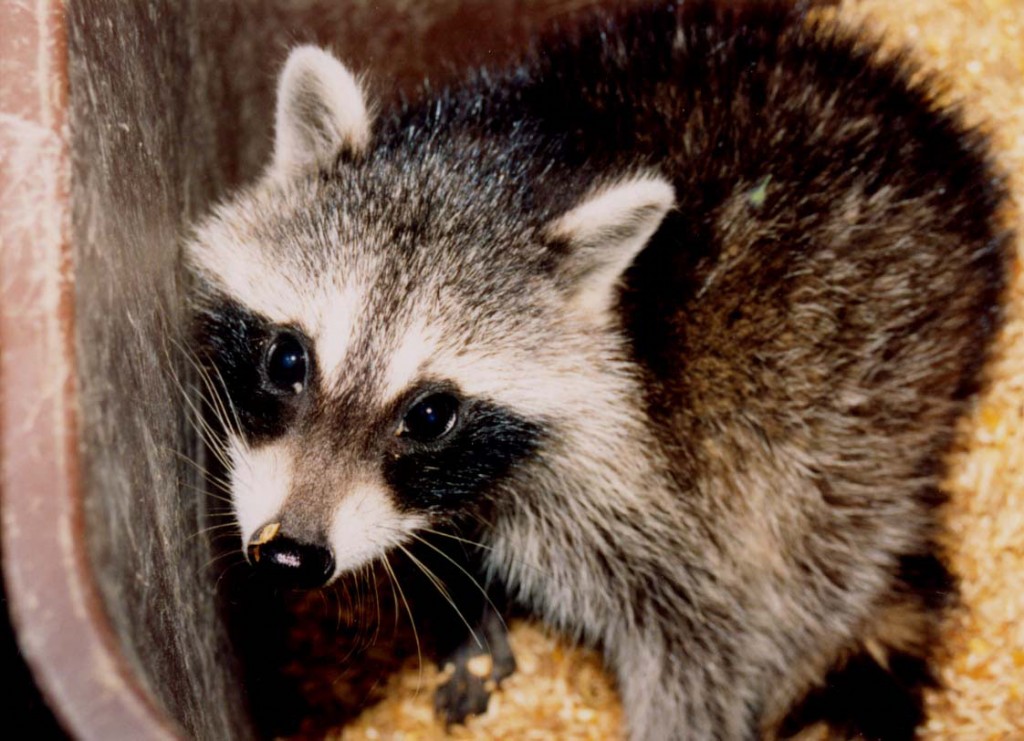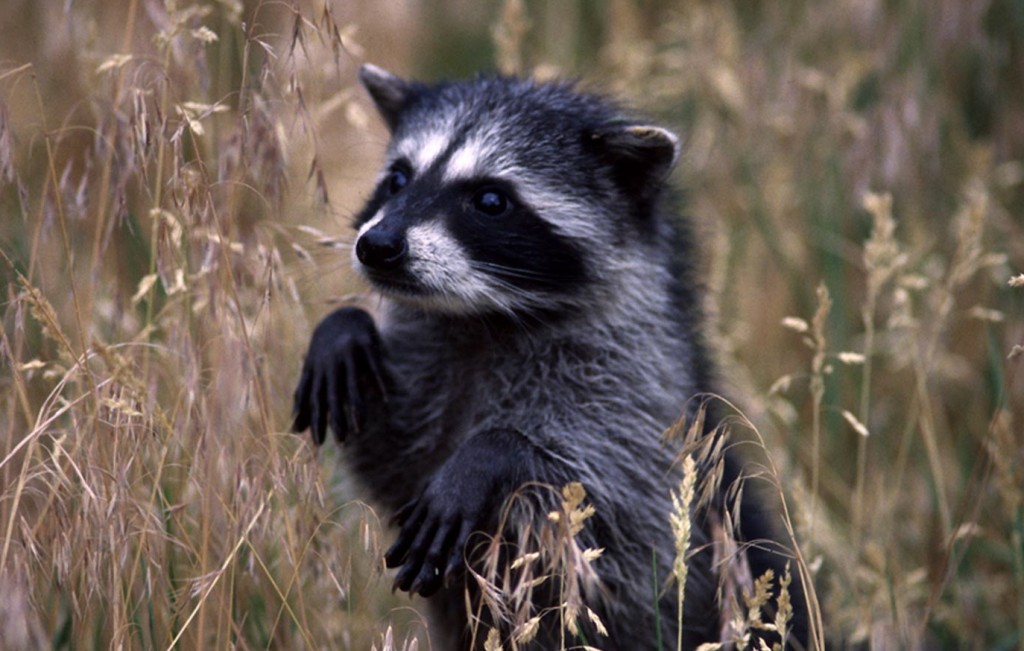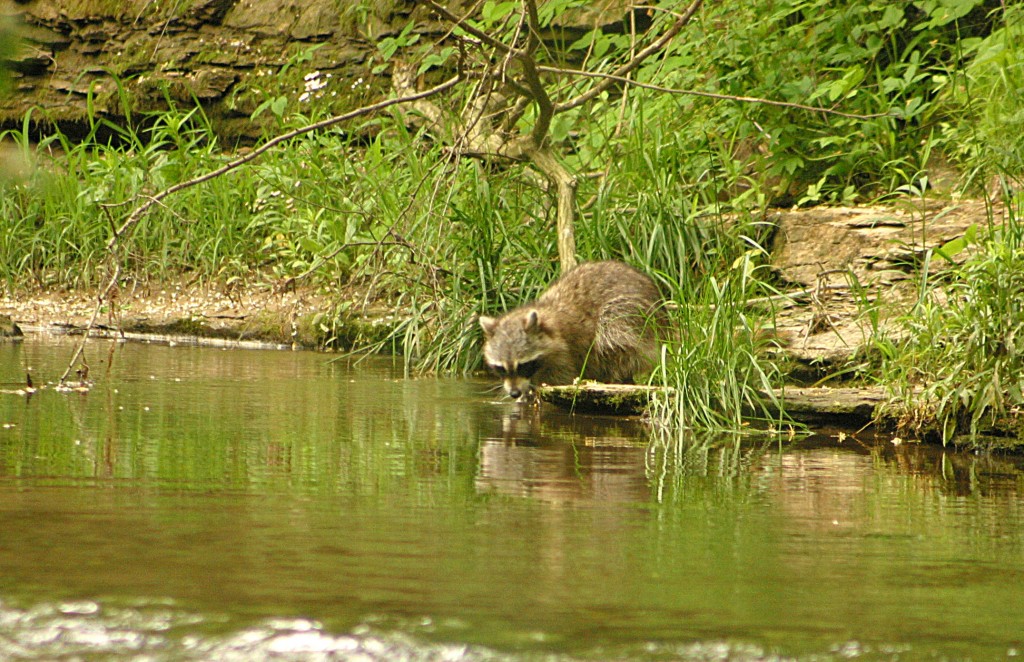Raccoons: Clever? Tricksters? Cute? ADAPTIVE
Raccoons, clever and cute, mischievous and tricksterish, have literally changed their lifestyles along with the rest of America. There are more raccoons living in Illinois and Monroe County today than there were in pre- and early-Euro-American settlement times and most now live in suburban and urban settings.
Raccoons owe their success to their adaptability and penchant for crafty opportunism, a virtue recognized by Native Americans. According to Amerindian legend, at the beginning of the world, both raccoons and opossums had long, hairy tails, which aided both in climbing and hanging in search of foodstuffs. One day, Opossum was walking in the woods and spied Raccoon. Opossum had always admired Raccoon because he had a beautiful tail with rings all around it.
So Opossum asked Raccoon: “How did you get those pretty rings on your tail?”
Raccoon stroked his fluffy tail and said: “Well, I wrapped bark around my tail here and here, and then I put it into the fire. The fur between the strips of bark turned black and the places underneath the bark remained white, just as you see!” Opossum thanked the Raccoon, did as instructed, and burned all the hair off his tail, which has been hairless, and less useful, ever since.
Raccoons (Procyon lotor) are large mammals, up to 37″ long, with a 12″ tail, and males can weigh up to 27 pounds. Females are slightly smaller and can weigh up to 20 pounds. They can live up to 10-11 years, but 3-4 is their normal life expectancy. Their vocal repertoire includes snarls and baby-like screams when fighting, but most often a whistle-like screech is used to communicate with each other.
Originally, raccoons lived in woodlands, near streams, ponds, or marshes. Now, however, large numbers inhabit agricultural and urban areas. In general, raccoons stay near sources of water. Dens are used for rearing young, retreats, and prolonged periods of winter inactivity. Dens can be large tree cavities, rock crevices, caves, abandoned burrows of other animals, hollow logs, brush piles, and sewers and culverts.
Raccoons are opportunistic feeders and will eat just about anything. During spring and summer animals are important in their diet, but the majority of food eaten in fall and winter is plant material. Overall, raccoons eat more plants than animals, and more invertebrates than vertebrates. Crayfish are their most important animal food, but they also will eat insects, mussels, fish, frogs, turtles, turtle eggs, earthworms, snails, rodents, rabbits, birds, bird eggs, and carrion.
Plant materials consumed include grapes, persimmons, pokeweed berries, blackberries, all fruit, acorns and nuts, seeds, grasses, corn and soybeans. Raccoons also raid gardens, bird feeders, garbage cans and pet food left outdoors.
Raccoons produce one litter a year. Males and females typically will mate with numerous partners. Breeding usually occurs during February or March. Only the female provides parental care. Most births occur during April or May. Each litter usually contains 3-4 pups; litters are smaller in southern Illinois than northern Illinois. Newborns weigh about 2½ ounces and their eyes do not open until they are 18-24 days old. When newborns are 8-12 weeks old they are ready to leave their dens and begin foraging with their mothers. By autumn, juveniles begin to forage independently, but the family will continue to den together, and the young do not disperse until the following spring.
Raccoons are mostly nocturnal and their active foraging and feeding begins after sunset and peaks around midnight. During the day they sleep in their dens or rest on a tree limb. They shift resting sites daily. Raccoons may remain dormant in their dens in winter for prolonged periods, but they do not hibernate. Except for females and their pups, which remain exclusive to themselves, raccoons will sometimes form communal groups of many individuals in their winter dens.
Raccoons are excellent climbers and swimmers. Their sensitive and dexterous forepaws are used to find and catch prey and manipulate and play with a variety of items. Scientific laboratory tests have proven them to be remarkable problem solvers, using their paws, and then even remembering how to master all sorts of containers, latches, and doors.
Bobcats, coyotes, foxes and large owls prey on raccoons, but people are their main enemy. Raccoons are trapped and hunted for their pelts and for sport. Trapping is on the decline in Illinois: 400,000 pelts were garnered in 1979, but only 40,000 in 2006. It is estimated that Illinois hunters killed 200,000 raccoon in 2006. And, of course, countless raccoons are road killed during their nighttime adventures. Nonetheless, raccoons remain abundant in Illinois, more now than at any time in Illinois’ natural history.
Raccoon populations began to increase dramatically after World War II. Several factors are responsible. The increase in corn and soybean production has insured a ready and steady food source for raccoons. Human demographic movement from urban to suburban and exurban homesteads has encouraged raccoon in-migration, where there are fewer predators, abundant food sources, and hunting and trapping restrictions. In fact, raccoons have become city critters.
One hundred years ago, a respectable raccoon required two square miles of suitable wooded or wetland territory to survive. Today, in rural Monroe County, it is estimated that 10-15 raccoons per square mile are thriving. In our cities and suburbs, particularly in the MetroEast – St. Louis area, raccoon populations are approaching 50 per square mile. In Chicago and its collar counties, recent studies have shown that 100 raccoons per square mile is commonplace.
Highly adaptable, creative and secretive, raccoons are here to stay. They may be among the few creatures we need not hike into our bluff lands to see — we might do better to go to a Wal-Mart parking lot at midnight.
Clifftop, a local nonprofit organization, is focused on preserving and protecting area bluff lands.
A version of this article appeared in the February 5th 2010 edition of the Monroe County Independent.
© 2010 all content rights reserved, Clifftop NFP.
Comments are currently closed.



